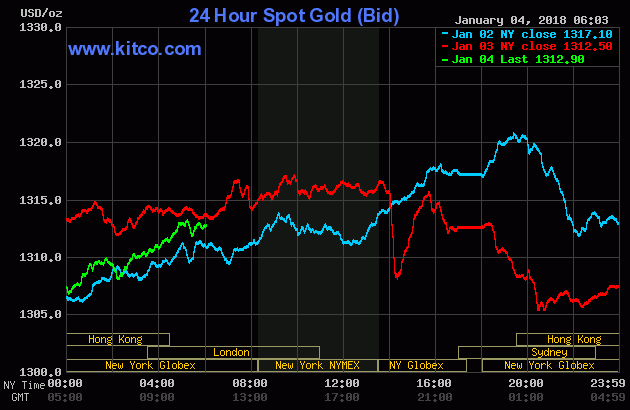On Wednesday, the minutes of the FOMC December meeting were released. What do they say about the Fed’s stance and what do they mean for the gold market?
The Fed Is Divided over Number of Hikes in 2018
At the December meeting, the U.S. central bank increased the federal funds rate by a quarter percentage point to a range 1.25-1.50 percent. The move was widely expected by investors, but there was no unanimity at the meeting as two FOMC members dissented. The Fed officials were also divided over the forecast of three rate hikes in 2018. The hawks noted that more hikes would be appropriate as financial conditions had not tightened since the Fed started raising rates at the end of 2015. On the other hand, the doves pointed out that too aggressive hiking might prevent a sustained return of inflation:
A few participants indicated that they were not comfortable with the degree of additional policy tightening through the end of 2018 implied by the median projections for the federal funds rate in the December SEP. They expressed concern that such a path of increases in the policy rate, while gradual, might prove inconsistent with a sustained return of inflation to 2 percent, or that the level of the federal funds rate might already be near its current neutral value. A few other participants mentioned that they saw as appropriate a pace of additional policy tightening through the end of 2018 that was somewhat faster than that implied by the December SEP median forecast. They noted that financial conditions had not materially tightened since the removal of monetary policy accommodation began, that continued low interest rates risked financial instability in the future, or that the labor market was increasingly tight.
However, the division will soften in 2018. The Committee will be more hawkish in 2018. Why? The biggest doves who dissented at the last meeting, Neel Kashari and Charles Evans, are not voting members in 2018. What does it mean? The risks to the forecast of three rate hikes are not balanced, but biased upwards. Currently, investors accept the forecast, with the market odds of a March hike at about 68 percent. If the expectations turn to be more hawkish over the year, gold may be under pressure. You have been warned.
Fed Doesn’t Believe in Huge Effects of Tax Reform
The last minutes showed that the FOMC members expect that the Republican tax plan will have only a modest impact on the economy. They revised up their forecast for real GDP growth beyond 2017, as the changes in the tax code would likely provide a modest boost to consumer and capital spending.
Beyond 2017, the forecast for real GDP growth was revised up modestly, reflecting the staff's updated assumption that the reduction in federal income taxes expected to begin next year would be larger than assumed in the previous projection. The staff projected that real GDP would increase at a modestly faster pace than potential output through 2019.
However, the Fed officials stated that the magnitude of the effects was uncertain, as companies could use the increase in cash flow for debt reduction or stock buybacks. Only time will tell the exact effects – we expect that the tax reform will benefit the U.S. economy, which is not good news for the gold prices. The near-term benefits are rather priced in the market, but investors haven’t taken all longer-term benefits into account yet. Remember. As the reform gives companies incentives to build plants in the United States rather than overseas, we are likely to see an increase in capital spending.
No Agreement on Inflation Outlook?
The debate about the path of rates was closely linked to the inflation outlook. The doves believe that the low inflation could remain soft. However, they were in the minority, as the FOMC members generally viewed the medium-term outlook for inflation as little changed. The majority of them continued to “expect inflation to gradually return to the Committee’s 2 percent longer-run objective.”
Indeed, “the staff projected that inflation would be very close to the Committee's 2 percent objective in 2019 and at that objective in 2020.” And “the risks to the projection for inflation also were seen as balanced.”
So much for low inflation as the reason for a more dovish Fed in the near future. The opposite is actually more probable, given all the personal changes in the composition of the FOMC.
Conclusion
The minutes from the latest FOMC meeting were rather hawkish. The U.S. dollar increased in a response, while the price of gold declined, as one can see in the chart below.
Chart 1: Gold prices over the last three days.

The FOMC members are still seeking a gradual rise in the U.S. interest rates, despite the internal division over the subdued inflation. In 2018, the biggest skeptics in such approach won’t vote, so we expect a more hawkish Fed. It should be a tailwind for gold. However, the first meeting with the new composition will tell us more. Stay tuned!
Disclaimer: Please note that the aim of the above analysis is to discuss the likely long-term impact of the featured phenomenon on the price of gold and this analysis does not indicate (nor does it aim to do so) whether gold is likely to move higher or lower in the short- or medium term. In order to determine the latter, many additional factors need to be considered (i.e. sentiment, chart patterns, cycles, indicators, ratios, self-similar patterns and more) and we are taking them into account (and discussing the short- and medium-term outlook) in our trading alerts.
